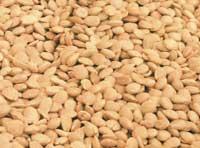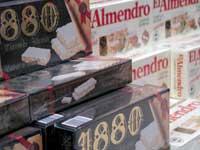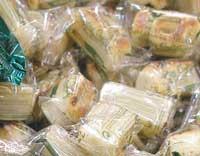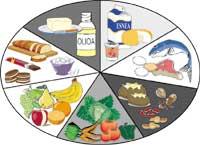Almonds
2003/12/01 Lorenzo, Arantza | Uranga, Ane Miren Iturria: Elhuyar aldizkaria
In fact, almond provides a lot of energy, 589 kcal/100 grams, and is rich in all nutritious ingredients. Its protein content is high, 13.3%, and its biological quality is good. Almond contains all essential amino acids in adequate amounts. Among plant foods, soy is the food with the best protein distribution, followed by almond.
It is also very rich in fats. In general, half the weight of almond is usually fat, but it must be said that it is a fat that helps balance blood cholesterol levels. In fact, 34.1% are monounsaturated fats and 11% polyunsaturated. In addition, it contains linoleic acid, basic for the human body.

On the other hand, carbohydrates are less abundant, 9.5%, so to balance the diet it is necessary to combine almonds with bread or sweet nuts (raisins, dried figs...).
As for mineral salts, it is rich in calcium and phosphorus, in addition to magnesium, potassium and iron. But besides being abundant in mineral salts, the proportion of these mineral salts is very suitable. The calcium (Ca)/phosphorus (P) ratio should be between 0.3 and 2 for maximum use of bodies. The most suitable Ca/P ratio for the human body is certainly milk (1.27), but almond is also very suitable (0.464) if compared with egg (0.26) or meat (0.05). These last two foods contain much more phosphorus than calcium, which prevents its correct absorption. Since the Ca/P ratio of almonds is relatively adequate, it is considered as mineralizing food. They are also rich in thiamine (B1), pyridoxine (B6) and vitamin E.
For all these reasons, and considering that it has many calories, almond is a highly recommended food for athletes or for those who do hard physical work. In addition, due to the type of fat it contains, those with high cholesterol levels can also be consumed in moderate amounts.
But, in general, we eat the almonds as a snack and not as substitutes for the second dish in dinner meals or as companions of the single dish (rice, pasta or vegetables with almonds, etc. ). Thus, we enrich and form foods rich in carbohydrates (rice, pasta...), healthy fats and proteins (almonds). And that's what we should do. As a second course, instead of eating meat, fish or egg, from time to time we would complete the first course with almonds, with a full and balanced meal.
Nougat and marzipan

The main raw material of both foods is almond. 50%-60% of marzipan is raw almonds, peeled and chopped and the rest is sugar (40-50%). That is why it can be said that it provides a lot of energy: 500-550 kcal/100 grams approx.
Marzipan sugar is normally sucrose, plus fat (25-30%) and protein (10-15%). Fat is vegetable and contains no cholesterol. Finally, almond also contains mineral salts and vitamins, but due to its high sugar and energy content, it is preferable to obtain these nutrients from other sources.
In addition to almond and sugar, many more raw materials are used: honey, albumin (a type of protein), hazelnuts, nuts, pine nuts, peanuts, coconut, cocoa, coffee, milk, cream, yolk or egg white, fine fruits (orange, lemon, strawberry...), rice, lentilla, etc.
The soft nougat is made with fine and toasted almonds, honey, sugar, egg white, albumin, water and authorized additives. The same raw materials are used to make the hard nougat but the whole almond is added.
Other types of nougat are called according to the raw materials used: chocolate, liqueur, fruit, etc. They all have about 500 kcal per 100 grams.

In view of these characteristics, it is clear that the consumption of nougat and marzipan should be greatly limited to people with problems of obesity, arteriosclerosis or diabetes. And for those who do not have such problems, better in moderation.
In the coming holidays you will surely have more than one chance to eat. You have to know how to enjoy these opportunities, but be careful with excesses. Tips to avoid abuse are:
- Although you will be on sale and well seen in the store, try not to buy them until the eve of the party.
- Do not open the nougat or marzipan until the first special dinner arrives and eat only at special celebrations.
- Buying in moderation, just what you need, so there will not be so much left for the next few days and you will surely not go hungry.
- Consume responsibly. Your pocket and health will thank you.

Gai honi buruzko eduki gehiago
Elhuyarrek garatutako teknologia






